Geologists are often surprised to find features on Earth replicated on other worlds; ancient riverbeds on Mars, lakes on Titan, and volcanic eruptions on Io. But researchers from the University of Washington have identified a geologic feature that exists on Mars…
But not on Earth.
These structures are known as periodic bedrock ridges. They look like sand dunes on the surface of Mars, but instead of sand piled high by strong winds, it appears that the wind has carved dune-like ridges right into the Martian bedrock.
“These bedforms look for all the world like sand dunes but they are carved into hard rock by wind,” said David Montgomery, a UW professor of Earth and space sciences. It is something there are not many analogs for on Earth.”
What could create such a unique feature? According to Prof. Montgomery, the ridges are probably a softer form of bedrock, which is easier for the Martian wind to erode it away. One similar feature on Earth is known as a “yardang”, but these are teardrop-shaped features parallel to the direction of the wind.

A yardang in Texas. Image credit: USDA
But on Mars, these periodic bedrock ridges are perpendicular to the flow of the prevailing wind, just how sand dunes form on Earth (and Mars).
The additional ingredient in the weather on Mars is probably some kind of deflection. The high speed surface winds are deflected up into the air by a land formation, and then they come down to the surface and create these periodic ridges. The length of the gap in the ridges depends on the strength of the wind, size of the deflection and the density of the atmosphere.
Apart from the fact that this is just really cool, there’s a scientific benefit too. This wind will expose layers of rock, created eons ago. A rover could travel across these ridges, sampling very different ages of Martian geology in a local area.
It would be an all-you-can-eat Martian geology buffet.
Source: Universe Today

No hay comentarios:
Publicar un comentario